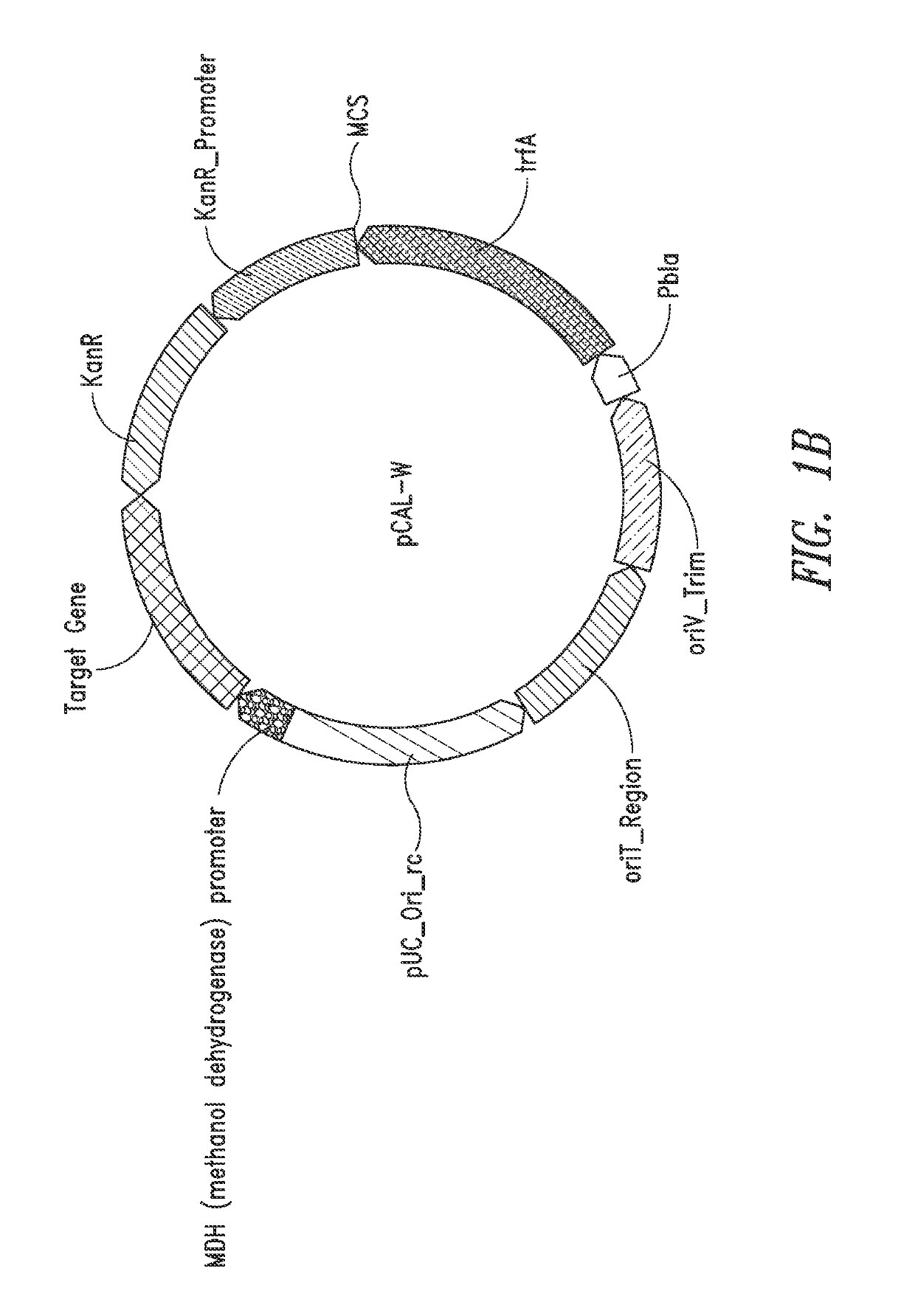Nucleic acids and vectors for use with methanotrophic bacteria
a technology of nucleic acids and methanotrophic bacteria, which is applied in the field of nucleic acids and vectors for use with methanotrophic bacteria, can solve the problems of methanotroph-incompatible antibiotics, difficult gene manipulation of such bacteria, and impeded use of methanotrophic bacteria
- Summary
- Abstract
- Description
- Claims
- Application Information
AI Technical Summary
Benefits of technology
Problems solved by technology
Method used
Image
Examples
example 1
LacI Inducible Promoters for Methanotrophs
[0154]Methylococcus capsulatus Bath strain was transformed with a vector containing a GFP (“Dasher”) expression cassette comprising the GFP-coding sequence and the MDH promoter (denoted as “native” in FIG. 3) as a positive control, a vector without any GFP expression cassette as a negative control, and a vector comprising an inducible GFP expression cassette as shown in FIG. 2A. This was accomplished as follows:
[0155]The vectors were first transformed into E. coli S17-1 using standard electroporation methods. Transformants were selected from kanamycin-resistant colonies grown on LB-agar containing 30 μg / mL kanamycin. Transformed colonies were inoculated into LB media containing 30 μg / mL kanamycin and shaken overnight at 37° C. Aliquots (e.g., 100 μL) of overnight cultures were used to inoculate fresh LB media containing 30 μg / mL kanamycin and then grown to an optical density (OD600) between 0.45-0.6 (mid-log phase growth). Aliquots of this s...
example 2
Constitutive and Inducible Production of a Target Product
I. Methylococcus capsulatus Bath Engineered for GFP or Lactate Production.
[0169]Host cells (Methylococcus capsulatus Bath) were engineered to possess an exogenous nucleic acid molecule encoding a green fluorescent protein (“Dasher”, SEQ ID NO.:33) or a lactate dehydrogenase enzyme to produce lactate from a C1 substrate (methane). Nucleic acid molecules encoding various different lactate dehydrogenases were codon optimized for Methylococcus capsulatus Bath and synthesized. The LDH encoding sequences were from Streptococcus pasteurianus, Lactobacillus helveticus, Bos taurus, Pediococcus acidilactici, Rhizopus oryzae, Enterococcus faecalis, Lactobacillus casei, Bacillus megaterium, Taeniopygia guttata, Lactobacillus plantarum, Lactobaillus acidophilus, Staphylococcus aureus, Bacillus caldolyticus, Actinomyces viscosus, Bacillus anthracis, Ruminococcus torques, Listeria marthii, Bacillus subtilis, Enterococcus faecium, Bacillus th...
example 3
A Sodium Benzoate Inducible Expression System for Methylococcus capsulatus Bath
[0190]Methylococcus capsulatus Bath strain was transformed with a vector containing a sodium benzoate inducible GFP expression cassette as shown in FIG. 8, according to the following procedures.
A. Media and Culture Conditions
[0191]If not stated otherwise, the following media and culture conditions were used in Examples 2, 3, and 4, and are referred to as “standard conditions.”
[0192]Escherichia coli cultures were propagated at 37° C. in Lysogeny Broth (LB). Where necessary, LB medium was solidified with 1.5% (w / v) agar and / or supplemented with 30 μg / mL kanamycin. M. capsulatus Bath cultures were grown in 25 mL MM-W1 medium in 125 mL serum bottles containing a 1:1 (v / v) methane:air gas mixture. The composition of the medium MM-W1 was as follows: 0.8 mM MgSO4*7H2O, 10 mM NaNO3, 0.14 mM CaCl2, 1.2 mM NaHCO3, 2.35 mM KH2PO4, 3.4 mM K2HPO4, 20.7 μM Na2MoO4*2H2O, 1 μM CuSO4*5H2O, 10 μM FeIII-Na-EDTA, and 1 mL pe...
PUM
| Property | Measurement | Unit |
|---|---|---|
| OD | aaaaa | aaaaa |
| pore size | aaaaa | aaaaa |
| pore size | aaaaa | aaaaa |
Abstract
Description
Claims
Application Information
 Login to View More
Login to View More - R&D
- Intellectual Property
- Life Sciences
- Materials
- Tech Scout
- Unparalleled Data Quality
- Higher Quality Content
- 60% Fewer Hallucinations
Browse by: Latest US Patents, China's latest patents, Technical Efficacy Thesaurus, Application Domain, Technology Topic, Popular Technical Reports.
© 2025 PatSnap. All rights reserved.Legal|Privacy policy|Modern Slavery Act Transparency Statement|Sitemap|About US| Contact US: help@patsnap.com



